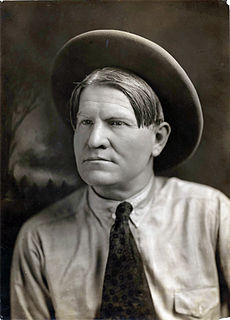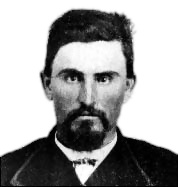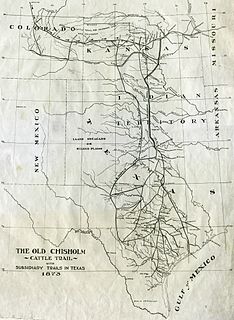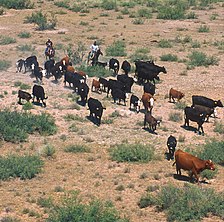
Charles Marion Russell, also known as C. M. Russell, Charlie Russell, and "Kid" Russell, was an American artist of the Old American West. Russell created more than 2,000 paintings of cowboys, Indians, and landscapes set in the Western United States and in Alberta, Canada, in addition to bronze sculptures. Known as 'the cowboy artist', Russell was also a storyteller and author. He became an advocate for Native Americans in the West, for instance supporting the bid by landless Chippewa to have a reservation established for them in Montana. In 1916 Congress passed legislation to create such a reservation, now known as the Rocky Boy Reservation.

Charles Goodnight, also known as Charlie Goodnight, was an American cattle rancher in the American West, perhaps the best known rancher in Texas. He is sometimes known as the "father of the Texas Panhandle." Essayist and historian J. Frank Dobie said that Goodnight "approached greatness more nearly than any other cowman of history."

John Horton Slaughter, also known as Texas John Slaughter, was an American lawman, cowboy, poker player and rancher in the Southwestern United States during the late 19th and early 20th centuries. After serving in the Confederate States Army during the American Civil War, Slaughter earned a reputation fighting hostile Indians and Mexican and American outlaws in the Arizona and New Mexico territories. In the latter half of his life, he lived at the San Bernardino Ranch, which is today a well-preserved National Historic Landmark in Cochise County in far southeastern Arizona.

The Chisholm Trail was a trail used in the post-Civil War era to drive cattle overland from ranches in Texas to Kansas railheads. The trail was established by Delaware scout and cattle rancher Black Beaver and his friend Jesse Chisholm who was a merchant. The southern terminus was a trading post near the Red River, and the Northern terminus was a trading post near Kansas City, Kansas. Both trading posts were owned by Chisholm.
Clayton Wheat "Claytie" Williams Jr. is an American businessman and philanthropist from Midland in the U.S. state of Texas who ran for governor in 1990. Despite securing the Republican nomination and initially leading in the polls against Democratic challenger State Treasurer Ann Richards by twenty points, Williams ultimately lost the race.
Gerald Lyda ) was an American cattle rancher, contractor and developer prominent in the state of Texas.

Newman Haynes Clanton, also known as "Old Man" Clanton, was a cattle rancher and father of four sons, one of whom was killed during the Gunfight at the O.K. Corral. Two of his sons were involved in multiple conflicts in Cochise County, Arizona Territory including stagecoach robbery and cattle rustling. His son Ike Clanton was identified by one witness as a participant in the murder of Morgan Earp. Billy Clanton and Ike were both present at the Gunfight at the O.K. Corral in which Billy was killed. "Old Man" Clanton was reportedly involved with stealing cattle from Mexican ranchers and re-selling them in the United States. Records indicate he participated in the Skeleton Canyon Massacre of Mexican smugglers. In retaliation, Mexican Rurales are reported to have ambushed and killed him and a crew of Cowboys in the Guadalupe Canyon Massacre.

Cattle drives were a major economic activity in the 19th century American West, particularly between 1856 and 1896. In this period, 27 million cattle were driven from Texas to railheads in Arkansas, for shipment to stockyards in Louisiana and points east. The long distances covered, the need for periodic rests by riders and animals, and the establishment of railheads led to the development of "cow towns" across the frontier.
Harold Dow Bugbee was an American Western artist, illustrator, painter, and curator of the Panhandle-Plains Historical Museum in Canyon, Texas. Bugbee sought with considerable success to become the dominant artist of the Texas South Plains, as his role model, Charles M. Russell of Montana, accordingly sketched life of the northern Great Plains.
The Southwestern Exposition and Livestock Show, known commonly as the Fort Worth Stock Show and Rodeo is the oldest continuously running livestock show and rodeo. It has been held annually in Fort Worth, Texas since 1896, traditionally in mid-January through early February. A non-profit organization, the Stock Show has provided millions of dollars in grants and scholarships in its tenure and continues to provide hundreds of thousands of dollars annually to assist the future leaders of agriculture and livestock management.

Patrick March Dearen is an author of 20 books of Western fiction and history. His newest release, the 2012 novel, To Hell or the Pecos, is set along a desolate, 79-mile section of the Butterfield Trail in the Pecos River country of West Texas. To Hell or the Pecos is the 2014 winner of the Elmer Kelton Book Award from the West Texas Historical Association.
Christopher Columbus Slaughter (1837–1919) was an American rancher, cattle drover and breeder, banker and philanthropist in the Old West. After serving in the Confederate States Army during the American Civil War of 1861-1865, he came to own 40,000 cattle and over one million acres of ranch land in West Texas. He became the largest taxpayer in Texas, and used his wealth to endow Baptist institutions. He was known as the "Cattle King of Texas."
Anne Valliant Burnett Tandy was an American heiress, rancher, horsebreeder, philanthropist and art collector from Fort Worth, Texas.

Samuel Burk Burnett was an American cattleman and rancher from Texas.
Daniel Waggoner was an early American settler and rancher in Texas. He also owned five banks, three cottonseed oil mills, and a coal company. He established the Waggoner Ranch, which spanned eight counties: Wise County, Clay County, Wichita County, Wilbarger County, Foard County, Baylor County, Archer County, and Knox County.
William Thomas Waggoner was an American rancher, oilman, banker, horsebreeder and philanthropist from Texas. He was the owner of the Waggoner Ranch, where he found oil in 1903. He was the founding President of the Waggoner National Bank of Vernon. He established the Arlington Downs and paid for the construction of three buildings on the campus of Texas Woman's University.
Electra Waggoner was an American rancher and socialite from Texas. She was an heiress to the Waggoner Ranch, one of the largest ranches in the United States. The town of Electra, Texas was named in her honor.
William B. Slaughter (1852–1929) was an American rancher, cattle driver, banker and county judge. Born into a ranching family, he drove cattle and ranched in New Mexico before acquired a ranch in Sherman County, Texas. He founded local banks in Texas and New Mexico, and he was tried but acquitted on suspicion of faulty loans. He retired in San Antonio, Texas.
John Bunyan Slaughter (1848-1928) was an American rancher and banker. Born to a ranching family, Slaughter ranched in Texas and New Mexico before acquiring the U Lazy S Ranch in Garza County, Texas in 1901 and managing it for nearly three decades.
John Scharbauer (1852-1941) was an American rancher. Born in New York, he moved to Texas in 1880 and became a large rancher in the Southwest. By the time of his death, his business empire included "operations in banking, corporate investments, oil lands, real estate and ranches which sprawled across four Texas counties and into New Mexico."









